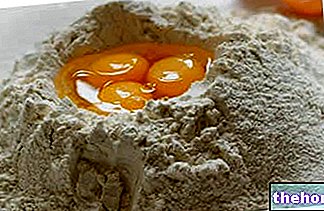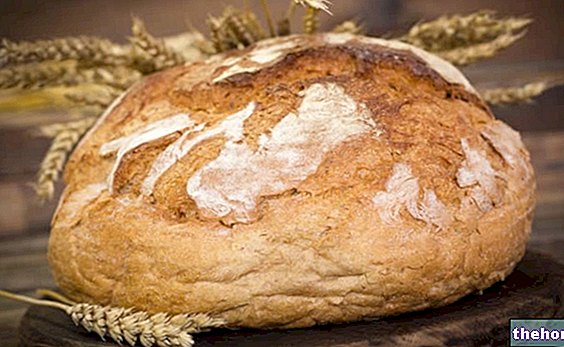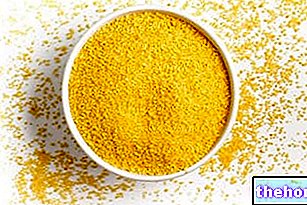Bakery products: general information
Bakery products are cooked foods with a high energy power, based on water, flour, salt (optional) and a leavening component (also optional).

What are they and with what differences?
Bakery products include a vast set of cooked foods, both leavened and unleavened, both sweet and savory, both simple and added in: salt, sugar, oils or fats, other cereals, other ingredients, etc. It is necessary to specify that baked products, precisely by virtue of this wide compositional heterogeneity, are not all the same and are not always SUBSTITUTABLE. As regards the nutritional aspects, the major differences lie in:
- Energy density (variable based on the amount of water, presence of added lipids, presence of added sucrose, presence of other added ingredients, etc.)
- Refinement of flours (which determines significant differences in the amount of fiber, mineral salts, vitamins, etc.)
- Hydration level (free water that contributes to satiety and the achievement of the recommended daily allowance)
- If present, quality of added fats (saturated, monounsaturated, polyunsaturated, hydrogenated, cholesterol and related metabolic impact)
- If present, amount of added salt (sometimes so high as to make them unsuitable for consumption by hypertensive people)
- If present, quantity of added sucrose (sometimes so high as to make them unsuitable for consumption by the diabetic and obese, and in any case harmful to dental health)
- If present, type of leavening agent (sometimes subject to food intolerances, allergies and cross-over with other allergies; may be related to the persistence of candidiasis)
NB. Any food additives present are deliberately not mentioned, as they would require excessive space in the article; consequently, please refer to another dedicated and more specific paragraph.
Without going into the merits of the classification of baked goods, which has already been addressed in the introductory article: Bakery products, below we will limit ourselves to listing the major exponents of the category, mentioning the important nutritional aspects.
Nutritional aspects
As anticipated, the nutritional aspects of baked goods vary according to the ingredients and processing. Assuming that all baked products are HIGHLY CALORIC and that ALL BRING SIGNIFICANT QUANTITIES OF COMPLEX CARBOHYDRATES, we try to understand which are more advisable for frequent consumption and which are less suitable if inserted frequently in the ordinary diet.
The most caloric SALTY baked goods are dry ones: crackers, breadsticks, pretzels, flatbreads, tortillas, taralli, croutons, etc., that is all those foods that, in addition to having considerable amounts of starch and very low percentage of water, they are characterized by the abundant addition of fats (more than oils ...) from seasoning. Excluding dietetic or "special" baked goods, the recipes of most dry savory baked goods include the use of hydrogenated fats, therefore the metabolic impact of food on lipidemia can only be decidedly unfavorable. even if it does not negatively affect the caloric intake, it must be specified that dry salted baked products bring high rations of sodium (Na) deriving from table salt, a very bad nutrient for those who already suffer (or are at risk) of arterial hypertension . Their consumption can NOT be recurrent and must NOT replace that of bread.
NB. A small exception can be made for cakes and similar products which, being made up exclusively of puffed cereals without adding anything, would be considered more balanced than the other members of the category.
The same goes for dry SWEET baked goods, therefore: dry biscuits, wafers, shortbread biscuits (including wholemeal ones), ladyfingers etc. Among other things, this category of foods has a further nutritional disadvantage, namely the addition of sucrose (simple sugar); this nutrient, in addition to increasing the glycemic index of the food and the overall energy, also increases the risk of dental caries.
"On average" less caloric, but still unbalanced, are the sweet HUMID bakery products: brioches, croissants, plumcakes, simple cakes, stuffed cakes, donuts, panettone, pandoro etc. They too, while making use of greater humidity, contain hydrogenated fats (or butter if the preparation is homemade), sugar, eggs and other filling ingredients (creams, jams, honey, dried fruit, dehydrated fruit, etc.). nutritional values, the great heterogeneity of the relative chemical characteristics immediately catches the eye; however, consumption may NOT be frequent or systematic.
Finally, we come to the nutritional aspects of salty (or not sweet) WET baked products; also in this case there is a notable variety and a fair variability of nutritional characteristics, but, without a doubt, the progenitor of the category remains the daily bread also called plain bread. The alternative preparations are: pizza, pinzone, focaccia, spianata, schiacciata, piadina, crescia, salty panettone, savory pies, kish, etc .; these, as "great taste" preparations, have a higher caloric and lipid content (as well as animal proteins).
There is some difference in the lipid quality of wet salted baked goods commercial and those household items (no doubt better), but on balance the distinction would not justify a systematic use. On the contrary, simple or daily bread (excluding niche preparations such as the "Ferrara couple", the "Venetian pan-biscuit", etc.) is a baked product that can be used daily. The energy intake is close to 300kcal (290 on average) and therefore the portions MUST adapt to the subjective caloric consumption; remember that bread has become, with technological development and the advent of well-being, a food of potential abuse; containing mainly carbohydrates (pure gasoline for the body), its excessive use in the diet risks overpowering energy consumption dictated by the basal metabolism and the level of overall physical activity, inexorably predisposing to the increase in fat mass and the worsening of metabolic parameters ( glycemia).
Other Cereals and Derivatives Amaranth Wheat starch Corn starch Rice starch Modified starch Oat starch Bulgur Whole grains Corn Flakes Crackers Oat bran Bran Cus cus Amaranth flour Oat flour Buratto flour Spelled flour Buckwheat flour Corn flour Corn flour Millet Barley flour Quinoa flour Small spelled flour (Enkir) Rice flour Rye flour Sorghum flour Flour and semolina Whole wheat flour Manitoba flour Pizza flour Spelled Rusks Focaccia Nuts Wheat or wheat Wheat germ Burnt wheat Buckwheat Breadsticks Oat milk Rice milk Corn Maizena Malt Millet Muesli Barley Stale bread Unleavened bread and Pita Bread Carasau bread Egg pasta Rice pasta Wholemeal pasta Piadina Small spelled Pizza Pop corn Baked goods Quinoa Rice Basmati rice Converted rice White rice Rice Wholemeal Parboiled Rice Puffed Rice Venus Rice Rye and Horned Rye Semolina Semolina Sorghum Spaghetti Spelled Teff Tigelle Triticale OTHER ARTICLES CEREALS AND DERIVATIVES Categories Food Alcoholics Meat Cereals and derivatives Sweeteners Sweets Offal Fruit Dried fruit Milk and derivatives Legumes Oils and fats Fish and fishery products Salami Spices Vegetables Health recipes Appetizers Bread, Pizza and Brioche First courses Second courses Vegetables and Salads Sweets and Desserts Ice creams and sorbets Syrups, liqueurs and grappas Basic Preparations ---- In the Kitchen with Leftovers Carnival Recipes Christmas Recipes Dietary Recipes Light Recipes Woman's Day, Mother's Day, Dad's Day Functional Recipes International Recipes Easter Recipes Recipes for Celiacs Recipes for Diabetics Holiday Recipes Valentine's Day Recipes Vegetarian Recipes Protein Recipes Regional Recipes Vegan Recipes




























